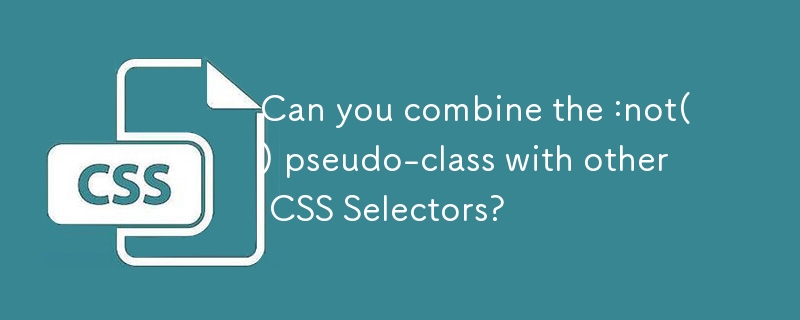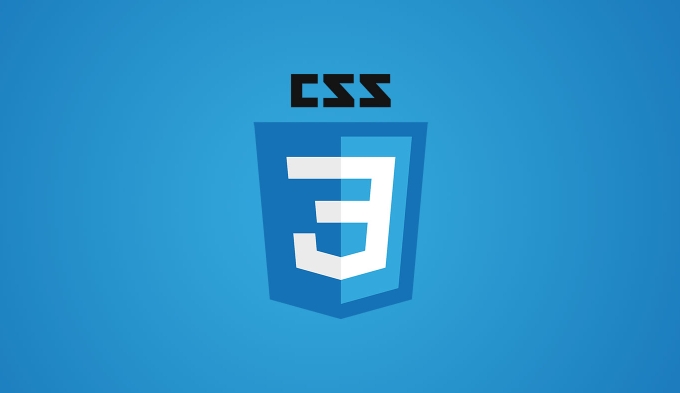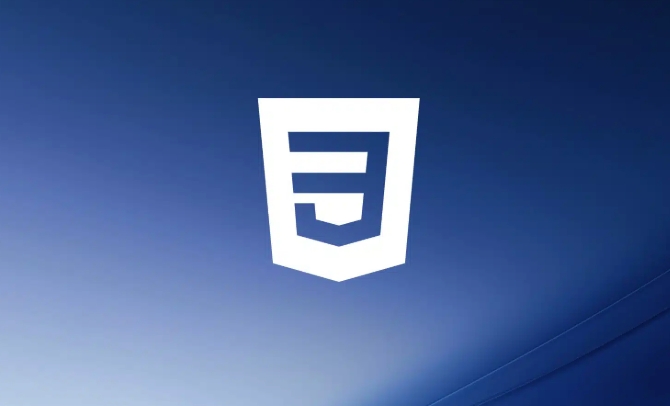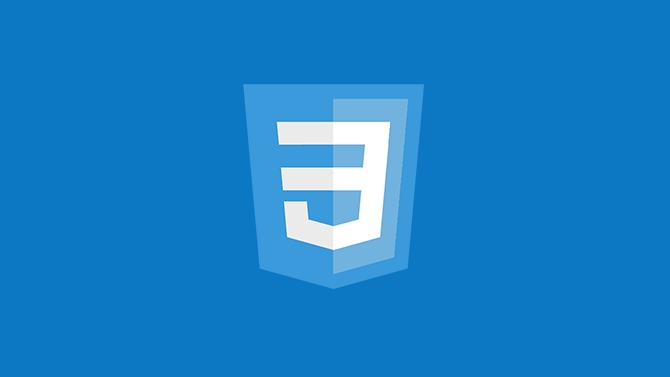Can you combine the :not() pseudo-class with other CSS Selectors?
Jul 03, 2025 am 12:39 AM <p> Yes, you absolutely can combine the
<p> Yes, you absolutely can combine the :not() pseudo-class with other CSS selectors. In fact, doing so is a powerful way to target specific elements while excluding others based on multiple conditions.

How :not() Works on Its Own
<p> Before diving into combinations, let's briefly recap how :not() works. It allows you to select elements that do not match a certain selector. For example:

p:not(.special) {
color: blue;
}<p> This rule applies blue text only to <p> elements that don't have the class .special . Combining :not() with Other Selectors
<p> You can layer :not() with other selectors like classes, attributes, pseudo-classes, and more. This helps refine your targeting without needing extra HTML classes or JavaScript. 
1. Combine :not() with Classes
<p> If you want to style all links except those with a specific class: a:not(.btn) {
text-decoration: underline;
}<p> This targets all <a> tags that are not using the .btn class — useful for avoiding conflicts with button styles.<p> A common use case: You might have a global link style but don't want it applied to buttons or nav items.
2. Use :not() with Multiple Conditions
<p> You can even stack multiple exclusions inside one :not() by separating them with commas: input:not([type="text"], [type="email"]) {
background-color: #f0f0f0;
}<p> This selects any <input> element whose type is not text or email . So checkboxes, radios, and file inputs would match.<p> Just remember: The comma inside :not() acts like an OR condition — it excludes anything that matches either selector listed. 3. Combine :not() with Pseudo-classes
<p> You can also pair :not() with pseudo-classes like :hover , :first-child , or :nth-of-type() .<p> For example: li:not(:first-child) {
margin-top: 10px;
}<p> This gives top margin to all list items except the first one. Great for spacing lists without adding unecessary classes.<p> Or another practical case: button:not(:disabled) {
cursor: pointer;
}<p> Here, the cursor will only show as a pointer on enabled buttons.
Some Things to Keep in Mind
-
:not()doesn't increase specificity much, but what's inside it does. For example,.class:not(.other)has class-level specification. - You can't nest
:not()inside itself (like:not(:not(...))) — it just gets ignored. - Avoid overcomplicating selectors. Simpler rules are easier to read and maintain.
<p> In short, combining
:not() with other selectors is totally valid and often helpful when you need fine-grained control over styling. Just keep it readable and test across browsers if needed.
<p> Basically that's it.The above is the detailed content of Can you combine the :not() pseudo-class with other CSS Selectors?. For more information, please follow other related articles on the PHP Chinese website!

Hot AI Tools

Undress AI Tool
Undress images for free

Undresser.AI Undress
AI-powered app for creating realistic nude photos

AI Clothes Remover
Online AI tool for removing clothes from photos.

Clothoff.io
AI clothes remover

Video Face Swap
Swap faces in any video effortlessly with our completely free AI face swap tool!

Hot Article

Hot Tools

Notepad++7.3.1
Easy-to-use and free code editor

SublimeText3 Chinese version
Chinese version, very easy to use

Zend Studio 13.0.1
Powerful PHP integrated development environment

Dreamweaver CS6
Visual web development tools

SublimeText3 Mac version
God-level code editing software (SublimeText3)

Hot Topics
 How can I include CSS only on some pages?
Jun 11, 2025 am 12:01 AM
How can I include CSS only on some pages?
Jun 11, 2025 am 12:01 AM
There are three ways to selectively include CSS on a specific page: 1. Inline CSS, suitable for pages that are not frequently accessed or require unique styles; 2. Load external CSS files using JavaScript conditions, suitable for situations where flexibility is required; 3. Containment on the server side, suitable for scenarios using server-side languages. This approach can optimize website performance and maintainability, but requires balance of modularity and performance.
 Flexbox vs Grid: Understanding the Key Differences in CSS Layout
Jun 10, 2025 am 12:03 AM
Flexbox vs Grid: Understanding the Key Differences in CSS Layout
Jun 10, 2025 am 12:03 AM
Flexboxisidealforone-dimensionallayouts,whileGridsuitstwo-dimensional,complexlayouts.UseFlexboxforaligningitemsinasingleaxisandGridforprecisecontroloverrowsandcolumnsinintricatedesigns.
 Creating an Auto-Closing Notification With an HTML Popover
Jun 10, 2025 am 09:45 AM
Creating an Auto-Closing Notification With an HTML Popover
Jun 10, 2025 am 09:45 AM
The HTML popover attribute transforms elements into top-layer elements that can be opened and closed with a button or JavaScript. Popovers can be dismissed a number of ways, but there is no option to auto-close them. Preethi has a technique you can u
 What is 'render-blocking CSS'?
Jun 24, 2025 am 12:42 AM
What is 'render-blocking CSS'?
Jun 24, 2025 am 12:42 AM
CSS blocks page rendering because browsers view inline and external CSS as key resources by default, especially with imported stylesheets, header large amounts of inline CSS, and unoptimized media query styles. 1. Extract critical CSS and embed it into HTML; 2. Delay loading non-critical CSS through JavaScript; 3. Use media attributes to optimize loading such as print styles; 4. Compress and merge CSS to reduce requests. It is recommended to use tools to extract key CSS, combine rel="preload" asynchronous loading, and use media delayed loading reasonably to avoid excessive splitting and complex script control.
 How to use Lotties in Figma
Jun 14, 2025 am 10:17 AM
How to use Lotties in Figma
Jun 14, 2025 am 10:17 AM
In the following tutorial, I will show you how to create Lottie animations in Figma. We'll use two colorful designs to exmplify how you can animate in Figma, and then I'll show you how to go from Figma to Lottie animations. All you need is a free Fig
 Breaking Boundaries: Building a Tangram Puzzle With (S)CSS
Jun 13, 2025 am 11:33 AM
Breaking Boundaries: Building a Tangram Puzzle With (S)CSS
Jun 13, 2025 am 11:33 AM
We put it to the test and it turns out Sass can replace JavaScript, at least when it comes to low-level logic and puzzle behavior. With nothing but maps, mixins, functions, and a whole lot of math, we managed to bring our Tangram puzzle to life, no J
 External vs. Internal CSS: What's the Best Approach?
Jun 20, 2025 am 12:45 AM
External vs. Internal CSS: What's the Best Approach?
Jun 20, 2025 am 12:45 AM
ThebestapproachforCSSdependsontheproject'sspecificneeds.Forlargerprojects,externalCSSisbetterduetomaintainabilityandreusability;forsmallerprojectsorsingle-pageapplications,internalCSSmightbemoresuitable.It'scrucialtobalanceprojectsize,performanceneed
 Does my CSS must be on lower case?
Jun 19, 2025 am 12:29 AM
Does my CSS must be on lower case?
Jun 19, 2025 am 12:29 AM
No,CSSdoesnothavetobeinlowercase.However,usinglowercaseisrecommendedfor:1)Consistencyandreadability,2)Avoidingerrorsinrelatedtechnologies,3)Potentialperformancebenefits,and4)Improvedcollaborationwithinteams.






